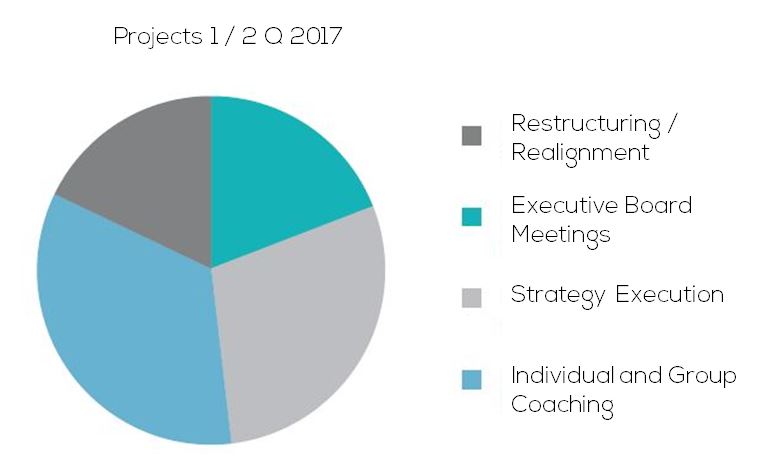1 BUSINESS DEVELOPMENT
Download my Business Report as a pdf. here.
My clients include major corporations as well as SMEs with national and international operations. In terms of new business, I have gained a family-run IT firm with strong growth. The majority of my projects have involved new and follow-on contracts with existing clients.

Cooperative partnerships with nationally and internationally focused business consultancies and professional networks have been intensified in recent months. I am delighted about solid contacts with successful solo consultants and groups of consultants such as the colleagues from context-consulting.de, plankton.de and SyNet-Group.com which is represented in 39 countries. Professional collaboration of this kind is a real pleasure.
2 FROM MY PROJECT WORK – EXPERIENCES
At the beginning of the year, my work is focused on facilitating executive board and strategy meetings “behind closed doors.” For me, these sessions represent some of the most critical junctures in the process of aligning an organization with future business options. And in most cases there are more options than a group of decision makers – in terms of group dynamics – can handle.
Incompatibilities arise when:
Individual players have doubts about the viability of strategic plans because
- they’re currently seeing completely different options,
- they’re troubled by fears of losing influence,
- they see routine business at risk,
- they view strategic changes as criticism of past performance.
This results in a number of discussion loops about the pros and cons of the strategic focus. While facilitating such processes, I take the liberty of asking questions like:
“How do you normally deal with conflicts?”
And if the humorous response is: “We just ride it out. That’s what we always do!” ample room has been created for bringing the hidden agendas, the relationship issues into the discussion. Whether this will subsequently lead to consensus within the executive team or to some form of horse trading is of secondary importance. The main thing is that all the players emotionally commit to their joint decision.
MY CONCLUSION: Causing strategic decisions to be made without paying attention to team dynamics is not a very promising approach.
REALIGNMENT OF A DEPARTMENT
Strategy development and execution processes can easily get out of hand in terms of time and content. This is particularly true when a large number of people are involved in the development and execution process.
Essentially, to ensure that the process remains manageable, there are two aspects that can be tweaked: the WHAT and HOW of the strategy. The WHAT includes the strategic goals, especially in terms of their numbers. The HOW includes a) the leadership style and b) the mode of execution.
All three factors are tackled in a workshop held for several days in a department in the tourism sector. The current state of the department:
- New team, new leaders
- New business segments
- New positioning within the company’s overall organization
- Collective sentiment: EVERYTHING’S NEW
With clear priorities (Must Wins) having been set by the leader, previously gathered strategic initiatives are put in focus in advance, with about 70% (!) of them either being sorted out again, put “on hold” or adjusted in terms of scope. For the participants, this is no mean feat. The remaining initiatives, though, are viewed as “golden” in reflection. The leaders of this team experience having to share only selected sub-strategies with their teams as a relief. This group of leaders enjoys omitting things.
Decisive for the execution mode, the HOW of the strategy, is that during the workshop the leadership team decides to work in “sprints” in the future. Small working groups will tackle a strategic sub-project and subsequently work on it within a few days before “going live” – exclusively dealing with and driving this single project.
Further into the workshop, an expectation pinned on the highest ranking leader is expressed:
“Show strong leadership!”
It is the call of the leadership team for orientation which, by the way, completely contrasts the company’s official culture that tends to expect its leaders to
“show empathy.”
The head of the business unit does not hesitate and urges his leaders: “Remain in the driver’s seat, make decisions and don’t wait for others to make the decisions for us. Keep our Must Wins in mind and take the initiative!”
Relief once more … coffee break.
MY CONCLUSION: Strategy execution has a lot do with high-ranking leaders allowing themselves to follow their own strong will and their own business acumen. Strategy requires clarity, arguments being brought force with a passion and, in case of doubt, assertiveness. The target groups welcome this, especially in times of new beginnings.
FROM MY COACHING WORK
Senior executives who in the wake of reorganizations or the spin-off of their business unit are suddenly faced with the loss of their role – not their job – are well-advised to reflect on their situation in a professional setting. In group coaching, I work with a group of high-ranking leaders on such questions as:
- How do I live and survive in my company in the current situation?
What future options are available to me, which ones are appropriate for me?
My experience: when executives who in their company have
- frequently gone the extra mile,
- led large units,
- done a good job in spite of all restrictions
lose their role, they are obviously tormented by the question: is this my own fault? The answer is soon found: obviously, not. The remaining frustration surfaces a little later again in the form of entitlement: the company owes me something!
This is both questionable and harmful because such patterns of thought are not part of the portfolio of “the company” and, accordingly, it will not respond to them. As bitter as this realization may be, the company doesn’t owe you anything.
MY CONCLUSION: People who are affected by such events benefit from adopting a less emotional attitude. Abandoning the idea of supposedly having a score to settle with the company provides relief and room for seeking other future options, new challenges and new effectiveness. And this is what the life of a leader is all about.
3 WHAT ELSE
To all the readers of this business and experience report:
Have a fantastic summer!
Best regards,
Andreas

